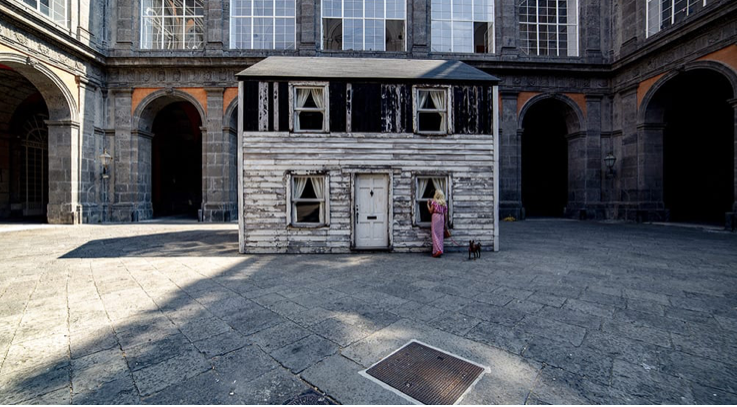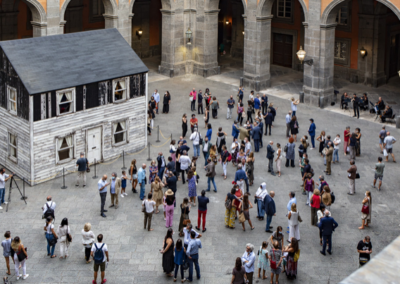Among history and collective memory
Ryan Mendoza has rebuilt in Naples, in the Courtyard of Honor of the Royal Palace, the house of the activist Rosa Parks.
Why did he do it? Who is Ryan Mendoza? And who knows or remembers the history of Rosa Parks?
The workshop leads first and second grade school classes on an interactive and participatory itinerary to answer these questions. Starting from the public dimension of art, we have explored the work of American artist Ryan Mendoza dedicated to the house of Rosa Parks, the African-American woman famous for her refusal to give up her seat on a bus to a white man in the United States, in Montgomery, Alabama in 1955. The house, originally located in Detroit, was saved from destruction and restored by Ryan Mendoza who, after a series of relocations, has decided to move it to Naples. Art allows us to shift our point of view by suggesting a critical and conscious look at the world.
In the first part of the workshop, thanks to multimedia materials, from videos to images of extreme power and beauty, it was possible to familiarize with Ryan Mendoza and especially with the historical figure of Rosa Parks. With the presentation of these materials, answers to the questions raised at the beginning were found by the students.
Afterwards we connected live with the artist Ryan Mendoza with whom it was possible to have a direct exchange and dialogue on the following issues:
-The artist’s gesture \ what can it represent ?
-The Monument – what is it and why is it important?
Again, thanks to the multimedia material, a brief excursus of significant examples was proposed in order to reflect on these two themes, leading to some very strong cases in which monuments were destroyed in order to deeply damage a population, a State, with dramatic examples from our contemporary history.
In the final part of the workshop, thanks to all the inputs gathered in the previous phases, the students were asked to make proposals on the fate of Rosa Parks’ house, reflecting on the concept of monument in relation to the role it has taken in history and art and its socio-political value.
During this planning phase, the questions that guided the work were:
Rosa Parks House \ What would you do with the house? Where would you place it?
Try to describe it with words, pictures, drawings, collages, models or other.
The work was accomplished with a division into groups.
Each group was invited to share their project made by different works creating a single narrative.
The workshop was developed in multiple meetings. The duration of each workshop was about an hour and a half.
Materials shared:
-Historical images of Rosa Parks
-Contemporary images of Rosa Parks ( illustrated books, cartoons, pictures from movies, etc.)
-Brief biographical information about Rosa Parks
-Images of the installation “The Rosa Parks House Project” at the Royal Palace
-Brief introduction on the artistic research of Ryan Mendoza
-Images of the “monument” reinterpreted among civil battles and contemporary art
Required Toolkit:
-Cell Phone
-White paper sheets
-Cardboards
-Boxes
-Natural elements (plants, leaves, flowers, soil, etc.)
-Colored papers
-Pencils
-Colors (crayons, markers, etc.)
-Pens
-Scissors
-Glue
Lesson learned
Interacting with the artist was an exciting experience for the students, allowing them to reflect on the process of the creation of the artwork and, in the case of Ryan Mendoza’s installation, with its social-political implications.
Students were able to ask questions and discuss with the artist the future of Rosa Parks’ home. We educators, for our part, have tried to break down the barriers of the “screen”, by creating a meeting that combines the theoretical part with the relational one, thanks to the intervention of the artist.
Tra storia e memoria collettiva
Ryan Mendoza ha ricostruito a Napoli, nel Cortile d’Onore di Palazzo Reale, la casa dell’attivista Rosa Parks
Perché lo ha fatto? Chi è Ryan Mendoza? E chi conosce o ricorda la storia di Rosa Parks?
Il laboratorio guida le classi di scuola di primo e secondo grado in un percorso interattivo e partecipativo per rispondere a queste domande. A partire dalla dimensione pubblica dell’arte, abbiamo approfondito il lavoro dell’artista americano Ryan Mendoza dedicato alla casa di Rosa Parks, la donna afroamericana famosa per aver rifiutato di cedere il posto su un autobus a un bianco negli Stati Uniti, a Montgomery in Alabama nel 1955. La casa, collocata originariamente a Detroit, è stata salvata dalla distruzione e recuperata da Ryan Mendoza che, dopo alcuni spostamenti, ha deciso di portarla a Napoli. L’arte ci permette di spostare il nostro punto di vista sulle cose proponendoci uno sguardo sul mondo critico e consapevole.
Nella prima parte del laboratorio, grazie a materiali multimediali, da video a immagini di grande forza e bellezza, è stato possibile familiarizzare con Ryan Mendoza e soprattutto con la figura storica di Rosa Parks. Con la presentazione di questi materiali sono state trovate e ricostruite dagli studenti le risposte alle domande fatte in apertura.
A seguire ci siamo collegati in diretta con l’artista Ryan Mendoza con cui è stato possibile avere un confronto e un dialogo diretto sulle seguenti questioni:
Il gesto dell’artista \ cosa può rappresentare ?
Il Monumento \ cos’è e perché è importante?
Anche in questo caso è stato proposto grazie a del materiale multimediale un breve excursus di esempi significativi per riflettere su questi due temi, fino ad arrivare ad alcuni casi molto forti in cui i monumenti sono stati distrutti per colpire nel profondo un popolo, uno Stato, con esempi drammatici della nostra storia contemporanea.
Nella parte finale del laboratorio, grazie a tutti i contributi elaborati nelle fasi precedenti, la classe è stata chiamata a farsi portatrice di proposte sul destino della casa di Rosa Parks, riflettendo sul concetto di monumento in relazione alla forma che ha assunto nella storia e nell’arte e alla sua valenza socio-politica.
Durante questa fase progettuale le domande che hanno guidato il lavoro sono state:
Casa Rosa Parks \ cosa fareste della casa? dove la collochereste?
Provate a descriverlo con parole, immagini, disegni, collage, plastici o altro.
Il lavoro avverrà con una divisione in gruppi.
Ciascun gruppo sarà invitato a condividere il suo progetto con i vari elaborati, per creare alla fine un’unica narrazione.
Il laboratorio si è sviluppato in più incontri. La durata di ogni laboratorio è stata di circa un’ora e mezza.
Materiali messi in condivisione:
-Immagini storiche di Rosa Parks
-Immagini contemporanee di Rosa Parks (albi illustrati, cartoni animati, illustrazioni, tratte da film, ecc.)
-Breve scheda biografica di Rosa Parks
-Immagini dell’installazione “The Rosa Parks House Project” al Palazzo Reale
-Breve introduzione sulla ricerca artistica di Ryan Mendoza
-Immagini sul “monumento” riletto tra battaglie civili e arte contemporanea
Kit di strumenti richiesti:
-Telefono Cellulare
-Fogli di carta bianchi
-Cartoni
-Scatole
-Elementi naturali (piante, foglie, fiori, terra, etc)
-Fogli colorati
-Matite
-Colori (pastelli, pennarelli, ecc.)
-Penne
-Forbici
-Colla
Riscontri
Confrontarsi con l’artista è stato per gli studenti un’esperienza entusiasmante, che ha permesso loro di riflettere sul processo di creazione di un’opera e, nel caso dell’installazione di Ryan Mendoza, con le sue implicazioni politico-sociali. Gli studenti hanno avuto modo di fare domande e discutere con l’artista del futuro della casa di Rosa Parks. Noi educatori, dal nostro canto, abbiamo provato ad abbattere le barriere dello “schermo”, creando un incontro che accanto alla parte teorica unisse quella relazionale, grazie anche all’intervento dell’artista.





